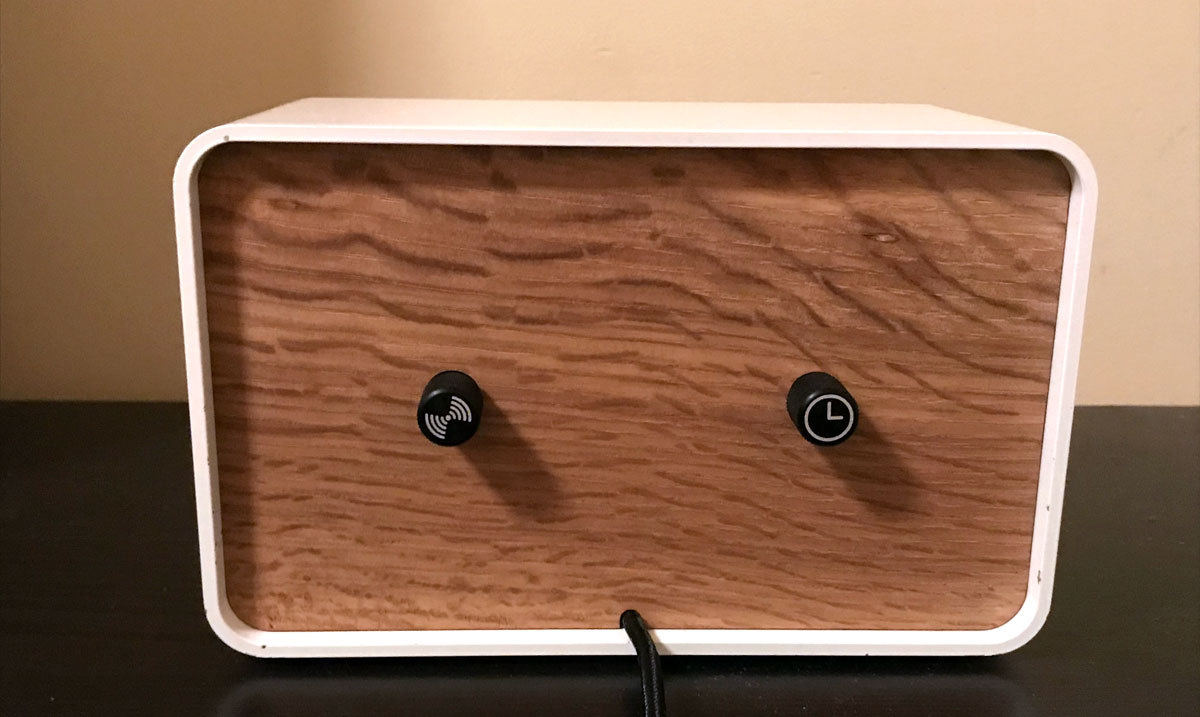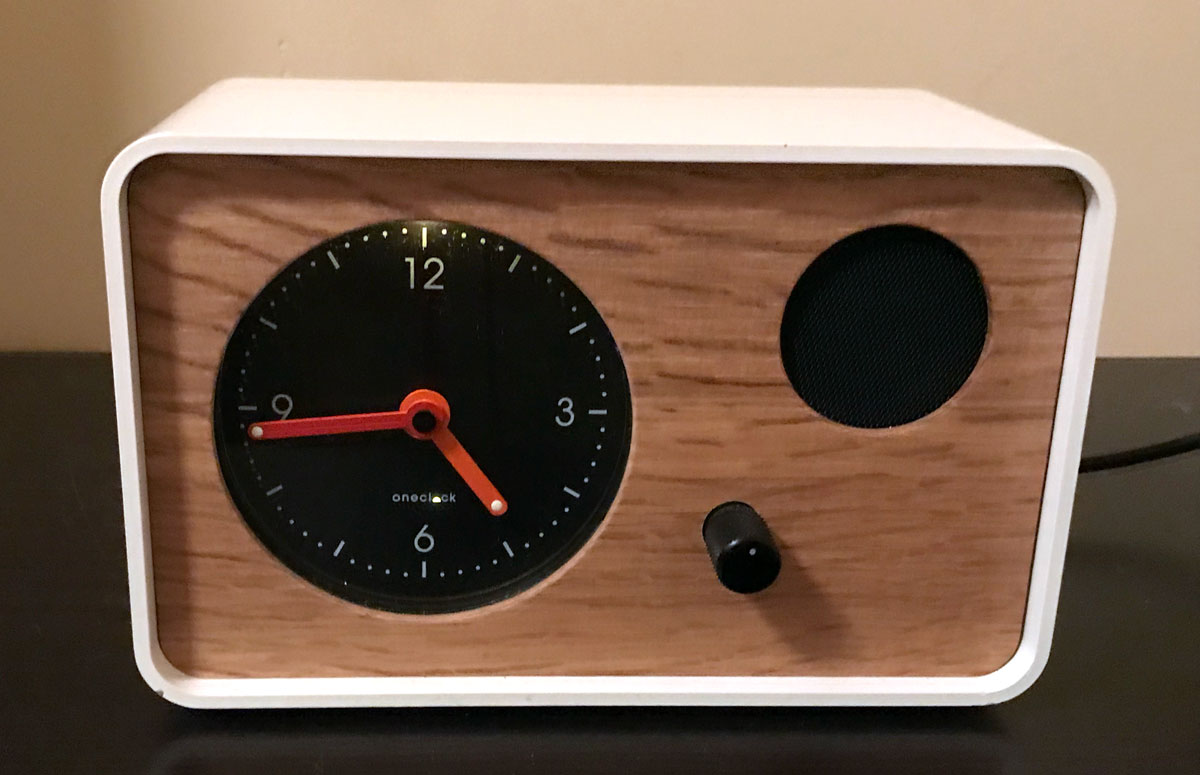Waking up to an alarm may be effective, but it’s also a stressful way to start your day. OneClock aims to change that with its analog, disconnected, not-an-alarm clock.
First, some details: OneClock is currently on Kickstarter and has blown well past its funding goal, with a little under two weeks to go. The pledge tier for a clock is $244 (until the early bird tier fills up, and then it’s $314) or there are a limited number of slots to get 2 clocks for $468. Waking up to science isn’t cheap! But is it worth it?
New to Kickstarter? Check out our crowdfunding primer.
Here’s the idea behind the OneClock: typical alarms wake you up with a lot of stress because they’re loud and blaring. OneClock plays various songs composed by Jon Natchez that sounds somewhat ethereal and builds gently—but is still loud enough to pull you out of sleep. It also randomizes the mix each time it plays a song so that your brain doesn’t get used to a particular sound and tune it out. The gradual fading in, the building intensity, and the variety are designed to be a better way to wake up.
The clock itself is a nice, minimal design: a powder-coated aluminum case, an oak face, and only a single knob on the front. The proportions are based on the Golden Ratio, and I have to admit it’s pretty to look at.

The clock uses a stepper motor (and has no second hand) and is silent, so no loud ticking at night when the house is quiet. There are two knobs on the back, which is otherwise plain: one is used to set the time, and the other is used to control the volume. The knob on the front has a couple of functions: setting the wake-up time, turning the alarm on and off, and sampling the music. You can also tap the clock to activate a nightlight for 5 seconds. The OneClock is powered by a built-in USB cable (standard adapter included), and has a battery backup to keep track of current time and alarm settings if the power goes out.
I was sent a working prototype of the OneClock to try out, and my family took turns putting it to the test over the course of the week. We each used it for a couple of days to see what it felt like waking up to the alarm.
I’m a snoozer—I have a beeping alarm clock and I’ll sometimes hit the snooze button once or twice before I drag myself out of bed, but I rarely sleep through the beeping entirely. The two days that I used the OneClock, I woke up to the music playing without any trouble, and definitely felt less stressed out than when I hear loud beeping, though it didn’t mean that it was easier to get out of bed. The OneClock doesn’t have a snooze button—an intentional design decision because, as they say on the Kickstarter page, “the snooze button is your frenemy”—so I did make myself get up rather than staying in bed, or I would have fallen asleep again.
My wife is an early riser—she gets up in time to have a workout before her work day starts—so her alarm is typically a few hours earlier than mine, which is set to get the kids up and ready for school. Generally, I don’t even hear her alarm at all. The two days that she used the OneClock, she found it easy to wake up to, but I also heard the soothing songs myself. So it’s definitely effective at getting through whatever part of my brain tunes out her alarm clock. That’s great if you need help waking up, but maybe not so great if your partner has a different schedule.
My middle kid (14) often has trouble waking up, though half the time it’s because she forgets to turn her alarm on anyway. Her two nights with the OneClock are hard to gauge because the first night she had her over-ear headphones on and didn’t hear it go off (though my youngest, who shares a room and gets herself up earlier without an alarm, reported that she heard the music). But she did wake up to it the second day, and then just stayed in bed anyway. Sigh.
My oldest (17) is the sort who sets several alarms throughout the morning, saying she doesn’t like to snooze but essentially pre-programming her snooze sessions in advance. She used the OneClock for two days, and then a third day, and then didn’t want to give it back. Her report is that it has woken her up each day on time, and she much prefers it to her phone alarms. The only issue is that she’s enjoying the songs, so sometimes she doesn’t want to turn it off. According to the Kickstarter page, that’s not a problem—the song will continue for 20 minutes if you want to just let it play for a while. (Unless, of course, you’re trying not to wake up somebody else.)
My youngest never has trouble getting herself up, so I didn’t try it out with her.

So, that’s been our week with the OneClock. I’m impressed with the way that it wakes us up—particularly that I woke up early when my wife was using it—and I enjoyed the few songs that I heard. (You can listen to some samples on the campaign page.) I haven’t used it enough times myself to hear the different remixes of the same melodies to see how they differ, so I can’t speak on long-term use.
There are a few quirks I’ll mention. For the alarm setting, the hands will actually spin around from the current time to your alarm time using the stepper motors. That’s different from other analog alarm clocks I’ve had in the past, where there may be an extra alarm hand that you set separately. Once you’ve set the alarm and clicked the knob, the arms spin back to the current time. While there is a volume knob on the back, I found that the actual range is pretty narrow, and I didn’t hear an appreciable difference between the softest and loudest settings. It’s small enough that I wonder whether it’s even worth having the volume dial at all.
Although the instructions say that you tap the clock for the nightlight, it seems to be simply triggered by sound or vibration. I’ve seen the light flick on in response to shutting the bedroom door, closing the armoire on the opposite side of the room, and setting my phone down on the nightstand next to the clock. Finally, since the clock doesn’t have an AM/PM indicator, neither does the alarm. When you turn on the alarm, it will sound the next time the hands reach that position, so you have to turn it on as you’re going to bed, rather than right after you wake up and turn it off.
One last thing: the OneClock is entirely disconnected. It has no wifi, no Bluetooth, no Siri or Alexa or Google. It’s meant to do one thing—help you wake up better—and to do it well. If you’re tired of waking up to buzzing, beeping, and blaring, it might be worth checking out. I know we (especially my oldest) will be sad to send the prototype back after our trial run.
For more information, visit the OneClock Kickstarter page!
Disclosure: I was loaned a prototype of the OneClock for review purposes. Links to the Kickstarter campaign are affiliate links and will give me a 1% commission on pledges. Opinions are my own.




